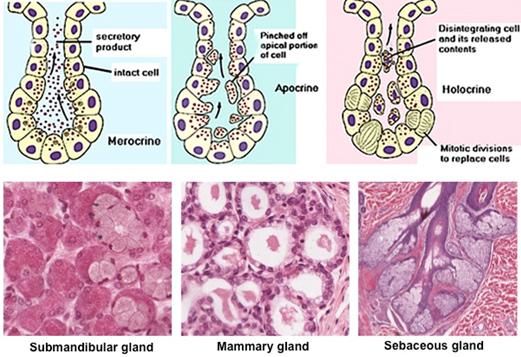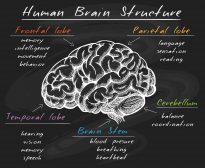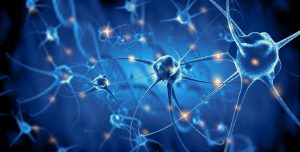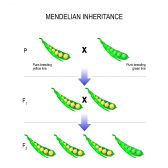
Apocrine glands
n., singular: apocrine gland
[æpəkraɪn ɡlænds]
Definition: Glands that secrete by decapitation
Table of Contents
The human body is a complex assemblage of many different organs, systems, glands, bones, and tissues. Weighing any one over the other doesn’t do justice to this nature’s complex yet neat assemblage. Hence, studying every part of the body not only brings clarity but also makes us understand the crucial roles associated with each one of them.
So, let’s get started with a definition of apocrine glands, a brief overview of glands, and then make our way into understanding deeper what an apocrine gland is, what triggers apocrine glands, characteristics, structure, function, prevalence, and clinical significance.
Apocrine Glands Definition
Apocrine glands are a sub-type of exocrine glands. They release their glandular apocrine secretions by the process of budding. Once the glandular contents are ready to be secreted, a bud forms and is eventually pinched off from the apocrine cells into the duct.
Since a part of the cell membrane is involved in the process of bud formation, it causes a little damage to the cells, too. In contrast to the other two modes of exocrine secretion, apocrine glands secretion not only has the “glandular content” but also has the additional “secretory cells content”.

Etymology of Apocrine
Apocrine is an early 20th-century word. It has been derived from two words, ‘apo’ an English word meaning “off” and ‘krinein’ a Greek word meaning “to separate”.

Biology definition:
Apocrine glands are a type of exocrine gland in which the secretory products are released together with some portions of the secreting cells, i.e. portions of the cell membrane budding off the cell. The secretory products of an apocrine gland are released from the cell through a portion of the cell membrane that encases them and eventually pinches off. Thus, the apocrine gland differs from the other exocrine glands (i.e. holocrine and merocrine glands) by including some parts of the cell with the secretory products. Examples of apocrine glands are mammary glands and the axillary sweat glands.
Etymology: apo (off) + krinein (to separate)
Compare: merocrine gland; holocrine gland
Overview of Glands
What is a gland? In simple language, a gland is an organ responsible for producing, processing, and releasing biologically-important substance/s in the complex human machinery. These biological substances or secretions are associated with very specific functions and roles inside our system.
So, now the next question is how many types of glands are there in our body?
To precisely state, there are two categories or types of glands in our body. The first category comprises endocrine glands and the second one is exocrine glands. Look at the table below to find the characteristic differences between the two types of glands.
Table 1: Differences between endocrine and exocrine glands | ||
|---|---|---|
| Characteristic Feature | Endocrine glands | Exocrine glands |
| Ducts | Absent | Present |
| Release of biological substances | Directly into bloodstream | Release via ducts (channels) to a specific site on the skin surface |
| Type of secretion | Hormones | Sebum, tears, sweat, enzymes, milk, saliva, mucus |
| Examples | Hypothalamus gland, adrenal gland, pineal gland, thyroid gland, pituitary gland | Sweat glands, mammary gland, sebaceous glands, lacrimal gland, salivary gland, esophageal gland, Brunner’s gland |
Data Source: Dr. Harpreet Narang of Biology Online
Within the exocrine glands, there are several ways to subcategorize the big group. We can divide the exocrine glands based on three different criteria.
- Based on the mechanism of secretion
- Based on the primary compound produced
- Based on the overall shape of the gland
But we will focus on the first criteria, which is based on the mechanism of secretion.
There are three types of exocrine glands. They are as follows:
- Merocrine gland
- Apocrine gland
- Holocrine gland
Just have a look at the tabulated differences below so that you are able to funnel down from glands to exocrine glands to apocrine glands.
Table 2: Differences between merocrine, apocrine and holocrine glands | |||
|---|---|---|---|
| Characteristic Feature | Merocrine glands | Apocrine glands | Holocrine glands |
| Type of gland | Most common | Less common than merocrine | Less common than merocrine |
| Type of secretion | By exocytosis | By budding and then bud breaks off | Cell membrane ruptures |
| Cell damage | None | Yes, as part of the cell membrane is lost as bud. (More damage than merocrine) | Yes, as the cell membrane is ruptured. (Maximum damage, as it causes even more damage than apocrine secretion) |
| Example | Eccrine gland | Mammary gland | Sebaceous gland |
Data Source: Dr. Harpreet Narang of Biology Online
Note it!
Apocrine glands are the more cell damaging glands than merocrine glands but less cell damaging glands than holocrine glands. They release their glandular secretions when a bud pinches off from the apocrine cell.
Structure
Before understanding the structure of apocrine glands, we present to you the general structure of exocrine glands as a whole.
General Structure of Exocrine Glands
Exocrine glands — no matter if they’re merocrine, holocrine, or apocrine — all of these glands are mostly made of two components. First is the “acinus” which is responsible for producing glandular secretions. And the second is the “duct” which is responsible for the transportation of these glandular secretions.
Now, there are three different cell types in the acinus of the exocrine glands. They are:
- Serous cell type (the glandular secretions are isotonic fluids with proteins, enzymes, etc)
- Mucinous cell type (the glandular secretions are mucus or mucilaginous in nature)
- Sebaceous cell type (the glandular secretions are sebum or oily in nature)
Specific Structure of Apocrine Glands
Some important points to note about the structure of apocrine glands are:
- Size: Larger in size than eccrine glands (eccrine sweat glands are a type of merocrine glands).
- Diameter: The diameter of apocrine glands = 10 times the diameter of eccrine glands.
- Parts: The 2 main parts of apocrine glands are…
- Coiled secretory structure (the apocrine gland): Exclusively made up of secretory cells
- A straight duct
- Origin: From hair germ. (This is the reason that apocrine glands very commonly enter the pilosebaceous follicle. Only a few times do we see the ducts of apocrine glands open into or onto the skin surface directly.)
- Cell type: The coiled structure of the apocrine gland is made up of a single layer of cuboidal or columnar cells.
Histological Study
Apocrine gland histology can be observed under a light microscope using various staining techniques. Cells in the apocrine glands can be differentiated with the aid of histological staining techniques.
The stains commonly used are hematoxylin, eosin, histochemical-specific stains, enzymatic-specific stains, and immunohistochemical-specific stains. See Figure 2 for the histological sample of an apocrine gland.
Apocrine Glands Function
There are various sites of our body where apocrine glands are present. They serve different purposes on all of these sites.
- Apocrine sweat glands function: Apocrine skin glands serve as human pheromones, scent production
- Thermoregulatory functions
- Apocrine breast/mammary glands function: Secretion of fat droplets into human breast milk
- Apocrine ear glands: Secretion of wax and formation of earwax
- Apocrine skin glands: Function as sweat glands
- Apocrine eye/lacrimal glands: Function as sweat glands
Apocrine Glands Location
Where are apocrine glands found?
We can find apocrine glands in many locations in the human body. Some of them are:
- Axillary region (armpit sweat glands)
- Areolar region (around the nipple)
- Anogenital region (around anus and genitalia)

Mechanism of Secretion
Decapitation: It is the process by which apocrine glands release their cellular contents into the gland’s duct. In this process, the release of content is ‘apical’ in nature. By apical nature, we mean that first, the cellular content accumulation happens at the “apical end” of the cells. After the apical end is saturated with the glandular product, it’s pinched off from the cell in the form of an “extracellular vesicle”.

Apocrine Glands Examples
Some examples of true apocrine glands are:
- Mammary glands
- Hair sweat glands
- Axillary sweat glands
Mammary glands were earlier considered modified apocrine glands. But studies have proved that they are true apocrine glands only.
Apocrine Glands Development
Apocrine glands develop primarily at puberty and start the secretion of milky sweat. Amongst these, the apocrine sweat glands typically showcase this age-related behavior. They are also called ‘odoriferous sweat glands’. They tend to produce an offensive odor associated with perspiration (sweating). The primary sites of these apocrine sweat glands are:
- Axillary regions
- Perineal regions
- Perianal regions
- Labia majora in ladies
- Scrotum and prepuce in gents
- Breast nipples
- Areolar region around the nipples
Note it!
Sweat glands (or sudoriferous glands) are of two types. They are eccrine and apocrine. Here, we discussed only the apocrine sweat gland. Both eccrine and apocrine sweat glands secrete their products at the sweat pore.
Watch this vid about apocrine sweat glands:
Prevalence
Apocrine glands aren’t just present in human beings. They are widely known to occur in animals too. Some of the animals where their presence has been noted along with some important functions are listed here.
- Horses: All over the body (Role: Thermoregulation)
- Skunks: All over the body (Role: Odor as a defense mechanism)
- Domestic animals (example, dogs and cats): At each hair follicle

Did you know…?
The prevalence of apocrine glands in the armpits is more common in men than women.
Clinical Significance
Apocrine glands are linked with many pathologies in the human body. Some of them are:
- Apocrine bromhidrosis
- Apocrine chromhidrosis
- Apocrine breast carcinoma
- Apocrine adenoma (First reported in breasts by Hertel et al. in 1976)
- Fox-Fordyce disease
- Hidradenitis suppurativa (acne inversa) (due to inflamed and infected apocrine glands)
- Hyperhidrosis (associated with overactive apocrine glands)
- Blocked apocrine glands can lead to odor build-up by the body’s flora interaction
- Apocrine metaplasia of breasts (often accompanied by apocrine lesions on the breast)

Featuring … “The Glands and The Pheromones”
The secretions of apocrine glands present an interesting case in mammals. While these same secretions play the main role of “thermoregulation” in our furry partners like dogs, cats, horses, etc, the secretions of apocrine glands in humans are known to be acting as “attractant” for the opposite sex!
Yes, you heard it right. Apocrine glands in the axillary regions (armpits) in humans are known to possess steroidal, oily compounds some of which are “pheromones”. These pheromones are released when you are sweating under the influence of emotions.
These apocrine glands are sensitive to adrenal glands. Therefore, when you are hit by emotions, these glands get activated and produce more pheromones. These stinking chemicals are not only used by human biology to attract another person but they are also released when you are hit by emotions of fear, anxiety, happiness, etc. This stink is related to the apocrine gland…
This ad shows the relation between apocrine glands and sweating. Image Credit: Sarah Everts.
Answer the quiz below to check what you have learned so far about apocrine glands.
References
- Freeman SC, Malik A, Basit H. Physiology, Exocrine Gland. [Updated 2021 Sep 28]. In: StatPearls [Internet]. Treasure Island (FL): StatPearls Publishing; 2022 Jan-. Available from: https://www.ncbi.nlm.nih.gov/books/NBK542322/
- Hertel, B. F., Zaloudek, C., & Kempson, R. L. (1976). Breast adenomas. Cancer, 37(6), 2891–2905. https://doi.org/10.1002/1097-0142(197606)37:6<2891::aid-cncr2820370647>3.0.co;2-p
- Elston, William D.; James, Timothy G.; Berger, Dirk M. (2006). Andrew’s Diseases of the Skin: Clinical Dermatology (10th ed.). Philadelphia: Saunders Elsevier. p. 7. ISBN 9780808923510.
- Murphrey, Morgan B.; Safadi, Anthony O.; Vaidya, Tanvi (August 10, 2020). Histology, Apocrine Gland. StatPearls Publishing. PMID 29489220.
©BiologyOnline.com. Content provided and moderated by Biology Online Editors.









